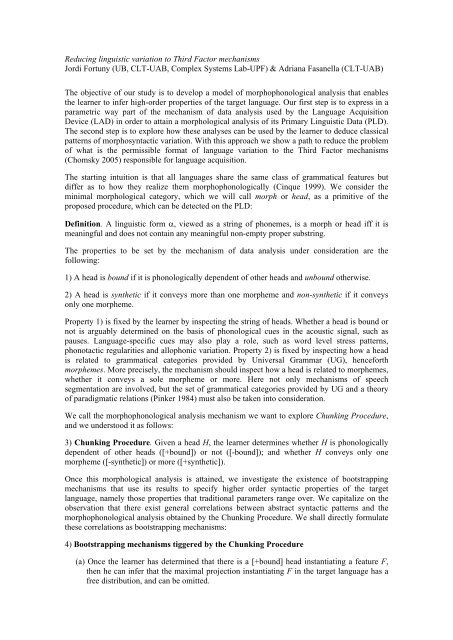Practical Information - Generative Linguistics in the Old World
Practical Information - Generative Linguistics in the Old World
Practical Information - Generative Linguistics in the Old World
Create successful ePaper yourself
Turn your PDF publications into a flip-book with our unique Google optimized e-Paper software.
Reduc<strong>in</strong>g l<strong>in</strong>guistic variation to Third Factor mechanismsJordi Fortuny (UB, CLT-UAB, Complex Systems Lab-UPF) & Adriana Fasanella (CLT-UAB)The objective of our study is to develop a model of morphophonological analysis that enables<strong>the</strong> learner to <strong>in</strong>fer high-order properties of <strong>the</strong> target language. Our first step is to express <strong>in</strong> aparametric way part of <strong>the</strong> mechanism of data analysis used by <strong>the</strong> Language AcquisitionDevice (LAD) <strong>in</strong> order to atta<strong>in</strong> a morphological analysis of its Primary L<strong>in</strong>guistic Data (PLD).The second step is to explore how <strong>the</strong>se analyses can be used by <strong>the</strong> learner to deduce classicalpatterns of morphosyntactic variation. With this approach we show a path to reduce <strong>the</strong> problemof what is <strong>the</strong> permissible format of language variation to <strong>the</strong> Third Factor mechanisms(Chomsky 2005) responsible for language acquisition.The start<strong>in</strong>g <strong>in</strong>tuition is that all languages share <strong>the</strong> same class of grammatical features butdiffer as to how <strong>the</strong>y realize <strong>the</strong>m morphophonologically (C<strong>in</strong>que 1999). We consider <strong>the</strong>m<strong>in</strong>imal morphological category, which we will call morph or head, as a primitive of <strong>the</strong>proposed procedure, which can be detected on <strong>the</strong> PLD:Def<strong>in</strong>ition. A l<strong>in</strong>guistic form α, viewed as a str<strong>in</strong>g of phonemes, is a morph or head iff it ismean<strong>in</strong>gful and does not conta<strong>in</strong> any mean<strong>in</strong>gful non-empty proper substr<strong>in</strong>g.The properties to be set by <strong>the</strong> mechanism of data analysis under consideration are <strong>the</strong>follow<strong>in</strong>g:1) A head is bound if it is phonologically dependent of o<strong>the</strong>r heads and unbound o<strong>the</strong>rwise.2) A head is syn<strong>the</strong>tic if it conveys more than one morpheme and non-syn<strong>the</strong>tic if it conveysonly one morpheme.Property 1) is fixed by <strong>the</strong> learner by <strong>in</strong>spect<strong>in</strong>g <strong>the</strong> str<strong>in</strong>g of heads. Whe<strong>the</strong>r a head is bound ornot is arguably determ<strong>in</strong>ed on <strong>the</strong> basis of phonological cues <strong>in</strong> <strong>the</strong> acoustic signal, such aspauses. Language-specific cues may also play a role, such as word level stress patterns,phonotactic regularities and allophonic variation. Property 2) is fixed by <strong>in</strong>spect<strong>in</strong>g how a headis related to grammatical categories provided by Universal Grammar (UG), henceforthmorphemes. More precisely, <strong>the</strong> mechanism should <strong>in</strong>spect how a head is related to morphemes,whe<strong>the</strong>r it conveys a sole morpheme or more. Here not only mechanisms of speechsegmentation are <strong>in</strong>volved, but <strong>the</strong> set of grammatical categories provided by UG and a <strong>the</strong>oryof paradigmatic relations (P<strong>in</strong>ker 1984) must also be taken <strong>in</strong>to consideration.We call <strong>the</strong> morphophonological analysis mechanism we want to explore Chunk<strong>in</strong>g Procedure,and we understood it as follows:3) Chunk<strong>in</strong>g Procedure. Given a head H, <strong>the</strong> learner determ<strong>in</strong>es whe<strong>the</strong>r H is phonologicallydependent of o<strong>the</strong>r heads ([+bound]) or not ([-bound]); and whe<strong>the</strong>r H conveys only onemorpheme ([-syn<strong>the</strong>tic]) or more ([+syn<strong>the</strong>tic]).Once this morphological analysis is atta<strong>in</strong>ed, we <strong>in</strong>vestigate <strong>the</strong> existence of bootstrapp<strong>in</strong>gmechanisms that use its results to specify higher order syntactic properties of <strong>the</strong> targetlanguage, namely those properties that traditional parameters range over. We capitalize on <strong>the</strong>observation that <strong>the</strong>re exist general correlations between abstract syntactic patterns and <strong>the</strong>morphophonological analysis obta<strong>in</strong>ed by <strong>the</strong> Chunk<strong>in</strong>g Procedure. We shall directly formulate<strong>the</strong>se correlations as bootstrapp<strong>in</strong>g mechanisms:4) Bootstrapp<strong>in</strong>g mechanisms tiggered by <strong>the</strong> Chunk<strong>in</strong>g Procedure(a) Once <strong>the</strong> learner has determ<strong>in</strong>ed that <strong>the</strong>re is a [+bound] head <strong>in</strong>stantiat<strong>in</strong>g a feature F,<strong>the</strong>n he can <strong>in</strong>fer that <strong>the</strong> maximal projection <strong>in</strong>stantiat<strong>in</strong>g F <strong>in</strong> <strong>the</strong> target language has afree distribution, and can be omitted.





